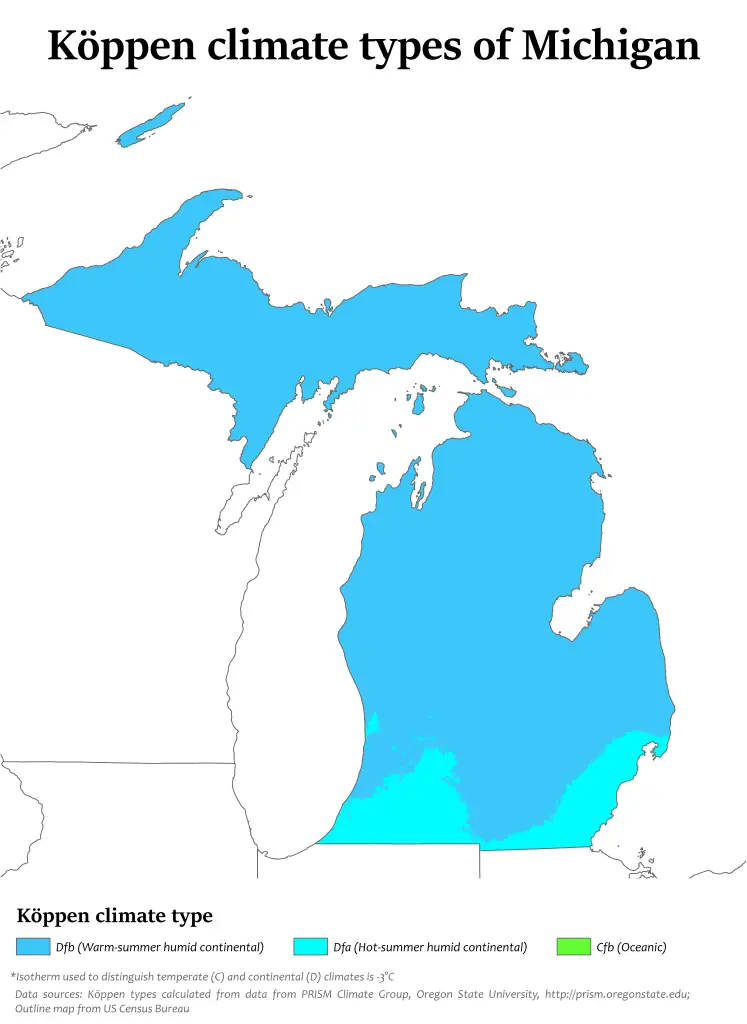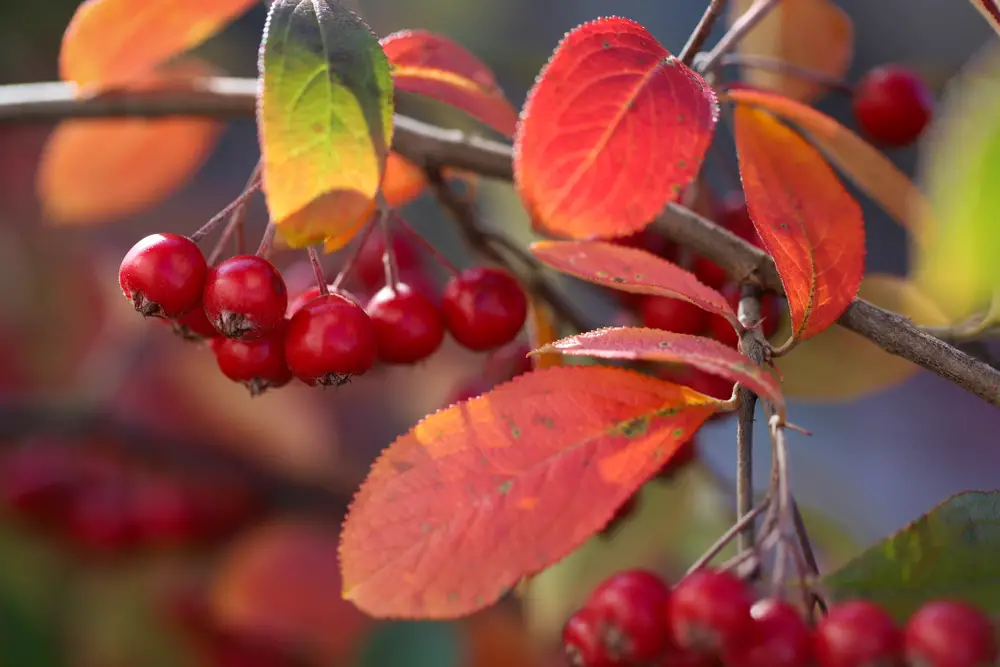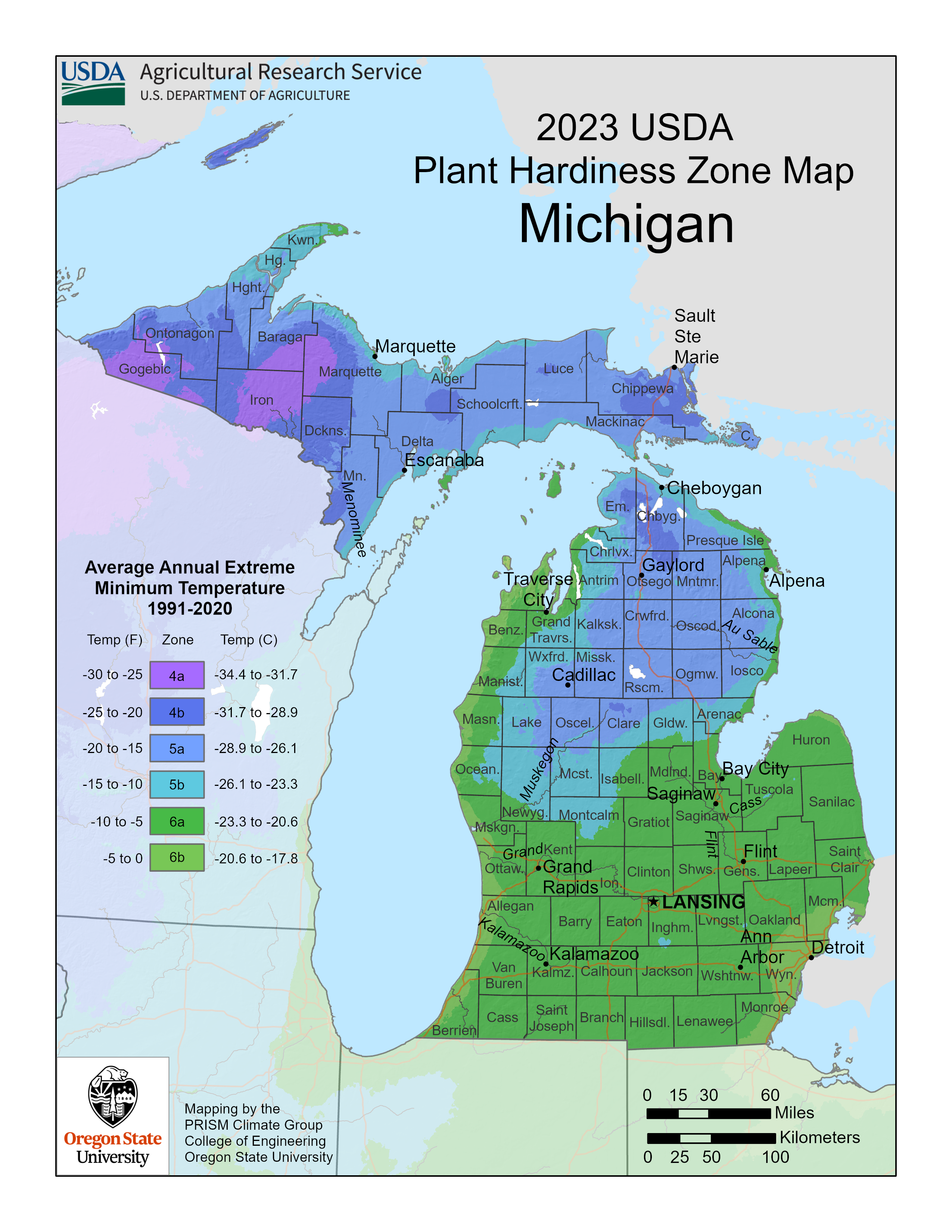Michigan Plant Hardiness Zones
| USDA Hardiness Zone | Average Minimum Extreme Winter Temperature Range Fahrenheit (°F) Celsius (°C) | Average Last Frost Date Range In Spring (Beginning Of The Growing Season) | Average First Frost Date Range In Autumn (End Of The Growing Season) |
|---|---|---|---|
| 4a | -30°F to -25°F -34°C to – 31.7°C | Mid to late May | Early to mid-September |
| 4b | -25°F to – 20°F -31.7°C to -28.9°C | Mid to late May | Mid to late September |
| 5a | -20°F to -15°F -28.9°C to -26.1°C | Early to mid-May | Late September to early October |
| 5b | -15°F to -10°F -26.1°C to – 23.3°C | Early to mid-May | Late September to early October |
| 6a | -10°F to -5°F -23.3°C to 20.6°C | Late April to early May | Early to mid-October |
| 6b | -5°F to 0°F -20.6°C to 17.8°C | Mid to late April | Late October to early November |
Michigan Growing Conditions
General Climate

Michigan has a continental climate defined by four distinct seasons with large temperature fluctuations between them.
Summers are often humid and warm and can experience extreme heat. The winters can experience extreme cold with snow. You’ll see more of the latter in the northern parts of the state.
Michigan has two distinct growing regions within the state. The northern part of the Lower Peninsula and the entire Upper Peninsula experience more extreme weather, with very long winters. This area can experience severe cold and snowfall at an average of 160 inches a year. The summers are short and warm, making the growing season shorter in this region compared to the south.
The central and southern areas of the Lower Peninsula have a slightly warmer climate, with hot and humid summers. The growing season is longer, and heat-loving plants like tomatoes do better here. This part of the state can experience dry seasons with periods of drought.
Michigan’s location in relation to four of the major Great Lakes has a large effect on its overall climate. These effects moderate the weather, making it more humid and temperate compared to other central and northern states.
Michigan experiences 41.8 inches of rain annually, with some areas of the state seeing more rainfall than others.
Microclimates
USDA plant hardiness zones are an important starting point for your garden, but you’ll also need to consider microclimates.
Microclimates are areas where specific conditions create a climate different from the climate they’re situated in.
Buildings, fences, paved areas, or short hills and valleys can create these microclimates.
They can be as small as a space in your backyard or as large as a city.
In other words, learn about your local conditions from local experts to see if your garden falls into a microclimate.
Extreme Weather
Winter Weather
The winter months can be severely cold in Michigan. Certain areas of the state experience more extreme weather, with longer, colder winters. Lake Superior and Lake Michigan affect the northern part of the Lower Peninsula and the entire Upper Peninsula, causing heavy lake-effect snow.
Lake-effect snow happens during cool weather seasons when the cold wind moves across large sections of the warmer lake water. The area collects water vapor from the warm lake. Once the vapor rises into the cool air, it freezes and causes large amounts of snow.
These areas of Michigan can see upwards of 160 inches of snow a year when the rest of the state normally averages around 30 to 40 inches.
Summer Droughts
While the northern portions of the state experience harsh winters, the southern areas experience an overall warmer climate with hot summers.
Summer droughts are common in Michigan, and it’s been predicted that the climate will only get hotter as seasonal droughts increase in the years to come.
This can be hard on the growing conditions and agricultural industry within Michigan, as water restrictions are common during drought phases. Plant wilt, leaf burning, and even mass plant death can occur if sufficient irrigation is not set up.
Choosing drought-tolerant plants is great for dealing with Michigan’s future climate.
Increased Flooding
Like drought, precipitation is also on the rise. Precipitation has increased from 22.7 inches annually in 1930 to around 41.8 inches in 2019. This is a big jump!
This state experiences more rain in spring, increasing the likelihood of flooding happening more often and becoming more intense during this time frame.
Flooding can have a huge effect on the agricultural industry as well as the home grower. With spring flooding more likely to occur, delayed planting times can occur. With an already short growing season, this can lead to large losses in yield and food production.
Start seeds indoors, and instead of planting them outside, pot them up into bigger pots. This can help extend the season and protect plants from the impacts of flooding.
Growing Season
Due to Michigan’s proximity to the Great Lakes, the overall length of the growing season can vary greatly. The last frost can range from mid-April until Late May, and the first frost occurs from Early September until early November.
On average, the growing season in Michigan is shorter, at approximately 140 days.
For avid veggie growers, especially in northern colder areas, use a greenhouse to extend the growing season. This will aid in growing tomatoes, cucumbers, peppers, and eggplant.
Michigan Gardening Tips

Improve Soil Quality
It’s sometimes easy to forget, but soil is arguably one of the most important factors in growing a biodiverse, successful garden. Healthy, good-quality soil will help improve your harvest. Building your soil takes time but is easy to do!
The first step to building soil is understanding what type of soil you have to begin with. Getting a soil test is an educational and fun way to understand what’s going on under your feet.
Soil tests can be as easy as a mason jar test at home to determine soil type. Store-bought kits can help you determine pH levels and nutrient deficiencies. You can even hire someone to take samples to a lab to get the finite details of your soil.
After you get a better understanding of what type of soil you have, you can work on building it with basic organic ingredients suited to your garden’s needs.
Some ingredients to building a better soil include leaf mulch from maple trees, grass clippings, garden lime, cardboard, compost and more! For acidic-loving plants like blueberries and lilacs, try adding coffee grounds into the soil.
Practice Companion Planting
Companion planting is where you choose to plant different veggies, herbs, and flowers together that benefit one another in their growing cycle. Companion planting helps mitigate against pests, helps build the soil by increasing nutrients, and can increase yields and overall health of the plants!
Don’t, for example, plant tomatoes alone! Try adding basil and marigolds to the mix.
Basil increases tomato plant yield and repels flies and mosquitoes. Marigolds repel garden pests, draw in beneficial pollinators, and taste great, too!
Some other companion plants for tomatoes include lavender, carrots, chives, parsley, lettuce, and spinach. Mixing all or some of the plants above can increase efficiency in the garden, suppress weeds, and bring in pollinators.
Consult With Local Professionals
Consulting with local gardening professionals allows you to benefit from their experience with your area’s conditions, the plants that do well there, and overall best practices.
Michigan Plant Suggestions

Trees
- Serviceberry (Amelanchier laevis)
- Black Gum (Nyssa sylvatica)
- White Oak (Quercus alba)
Shrubs
- Blackhaw Viburnum (Viburnum prunifolium)
- Red Chokeberry (Aronia arbutifolia)
- Michigan Holly (Ilex verticillata)
Flowers
- Canada Anemone (Anemone canadensis L.)
- Wild White Yarrow (Achillea millefolium)
- Purple Coneflower (Echinacea purpurea)
Vegetables
- Tomatoes (Solanum lycopersicum)
- Lettuce (Lactuca sativa)
- Asparagus (Asparagus officinalis)
Herbs
- Yellow Giant Hyssop (Agastache nepetoides)
- Peppermint (Mentha piperita L.)
- Oregano (Origanum vulgare)
Spices
- Basil (Ocimum basilicum)
- Parsley (Petroselinum crispum)
- Cilantro (Coriandrum sativum)
Fruits
- Paw Paws (Asimina triloba)
- Juneberry (A. canadensis)
- Low Sweet Blueberry (Vaccinium angustifolium)
Succulents
- Eastern prickly pear (Opuntia humifusa)
- Brittle prickly pear cactus (Opuntia fragilis)
- Hardy Sedum (Sedum kamtschaticum)
Disclaimer
Any of the above can change and is not exhaustive.
Treat anything above like a good starter guide. Then use that as a foundation as you consult with local gardeners, professionals, forecasts, guides, and organizations.


Leave a Reply